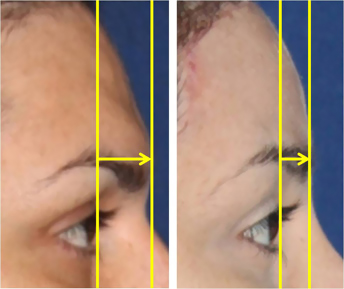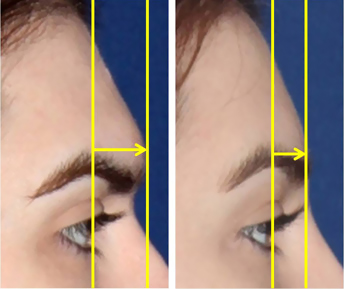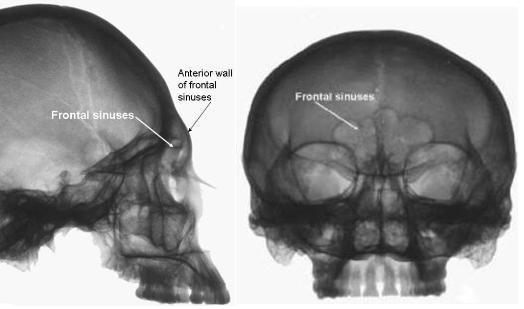The forehead is one of the facial features that more clearly reveals whether a person is male or female. Male foreheads are markedly different from female ones, although most people don't realize it.
A female forehead is considered pleasant when it shows a smooth and even surface. They tend to draw a vertical line on the facial profile. Male foreheads are instead sloped with a pronounced brow bossing. This brow bossing (brow ridge) is solid bone on the orbital rims, but hollow over the frontal sinuses, right above the nose.
The male hairline tends to be shaped like an M, whereas in women it tends to be shaped like an arch and it’s closer to the eyebrows.
The reconturing of a forehead bone can be done alone or as part of a facial feminization surgery. The most frequent incision is made along the hairline, just in front of it, but in some cases it can be done across the hair bearing scalp as well, in order to better conceal the resulting scar. The hairline incision is the preferred one when the patient has a receding hairline and wants to correct it along with the forehead contouring. It also allows doing a brow lift without lifting the hairline at the same time.
In some cases, grinding down (“shaving”) the brow ridge is enough to obtain a forehead feminization, but in about 95% of the cases, a reconstruction of the external wall of the frontal sinuses is necessary (see below Forehead Reconstruction or shaving? What type of forehead contouring surgery suits my forehead best?)
Then, using the same incision, the surgeon lifts the soft tissues of the forehead to adapt the eyebrows to the new skull outline and to give them a more feminine shape, which is called forehead lift or brow lift. If necessary, a feminization of a male hairline can be achieved by softening the corners of the M shape and/or advancing the scalp up to 2cm towards the forehead.
What makes this facial area look feminine is not only the brow-ridge shape but also the amount of projection the whole forehead bone has over the eyes (even if doesn't show a brow ridge at all) . These pictures show examples of the forehead reconstruction procedure and belong to 2 different patients with different degrees of brow bossing. Shaving the forehead bone wouldn't have been enough to achieve a good extent of feminization, and thus the reconstruction procedure was chosen for all of them. The photos were taken at different stages of recovery, so some of them still show some swelling. The yellow lines indicate how much the distance between the forehead surface and the eyes surface was reduced and how much this reduction of the brow bossing changed the perception of the forehead from male into female. Female eyes look female not because of any difference in the eyes themselves, but due to differences in the surrounding facial bones.


In order to set back the projection of a male forehead to a female range, several procedures can be used, being reconstruction and shaving the most common. Shaving is also called burring or grinding. What is the difference between reconstruction and just shaving? The brow bossing is a kind of external shell that covers two empty cavities called frontal sinuses, which are within the frontal bone. These facial x-rays show them.

This external shell of the forehead bone can be shaved up to the point where the frontal sinuses are reached. That is the limit for "forehead shaving " because going further would mean getting through the wall and leaving the sinus uncovered. This shell (called anterior wall of the frontal sinus) can be thin or thick, depending on the patient's facial skeleton. When it is thinner than the amount of reduction needed (the vast majority of cases) a “reconstruction surgery” of the frontal bone surface becomes the technique of choice for the recontouring to result in a real feminization. "Reconstruction" (popularly known as type 3 procedure) means removing the external wall of the forehead bone in a way that the sinus gets uncovered, shaving the surrounding surface and the orbital rims to reduce their projection, and then putting the external wall back to cover the sinus again (like it if it were a bony cap). This generates a new forehead surface that is placed more backwards than before. In order for the grafted external wall to remain immobilized until it knitts together with the surrounding bone, some titanium materials are used, such as very thin mini plates (or sometimes maleable mesh) and tiny screws. Bone cement made of hydroxyapatite (also known as bone substitute) is used as a "finishing plaster" to even out any resulting gap and to speed up the healing/bonding process of the bone.
By means of a "forehead reconstruction surgery" the forehead projection can be set back as close to the ideal female range as needed. Some of our patients got about half inch of projection removed. Many times the nose must be operated along with the forehead contouring because the surface of the forehead is moved more backwards than where the top of the nose is.
It is important to point out that although forehead recontouring is agressive surgery, it is just facial plastic surgery and in no cases will the brain be exposed, since all the work is done on the external surface of the skull, no matter which contouring technique is used (shaving or reconstruction). This means that there is an anatomical limit for the setback, and it is the poterior wall of the frontal sinus (the one that separates the sinus from the brain). If this posterior wall is placed too close to the external wall (in other words, if the depth of the sinus is lower than the amount of setback needed), then the external wall can't be pushed back as much as needed as it can't be pushed behind the posterior wall. This anatomical situation is not common, though.
Some patients don’t need to undergo a full facial feminization surgery to obtain a satisfactory degree of feminization. In some cases, a surgery of just forehead and nose can be enough for them. This is because the relative importance of the forehead in the perception of the facial gender is much higher than the relative importance of the lower face, as the forehead affects something crucial: it affects the way the eyes look. It is amazing how something as abstract as the look of the eyes can be changed by reshaping hard bone. A male bone frame around the eyes gives the look the fierce, severe or even grim character of the predators, probably an heritage from the age when male were hunters and fighters and women stayed at home caring after the children. Feminization surgery of the forehead and nose gives the patient’s eyes the look of the female eyes. This look, so appreciated by romantic poets, is not female because of anything in the eyes themselves (which are the same flesh balls in both males and females), but because of the shape, thickness and especially the projection of the bones that surround them.
The forehead recontouring (brow bossing reduction surgery) is perhaps the facial surgery that hurts the least during the recovery period (whether the recontouring procedure performed is shaving or reconstruction). It usually gets rid of swelling before other facial areas too (swelling is mostly liquid and slides down from top to bottom). It might be numb for some time after the recontouring, but during the following 6 months the sensation will gradually become normal again. Usually the eyebrows take several months to settle into a definitive position, which can limit facial expressions meanwhile. Bruises may appear and descend to lower facial areas before vanish. If a scalp advance was done along with a forehead recontouring, you will have a scar along the hairline. You may be able to return to some of your social activities 10 days after the forehead contouring surgery. A head scarf will help conceal the scar. You will have to wait at least one month after the forehead contouring surgery prior to do any hard work or physical exercise. Sleeping with your head elevated and ice packs on the brow bossing area during the first days favor the healing process.
During the first weeks after forehead contouring some patients tend to suffer from depression. You may find it difficult to come to terms with the new look of your brow bossing and you may even feel that having a surgery was a big mistake. But don’t worry: most of people who today are happy and satisfied with the results of their forehead feminization surgery have also gone through that phase.
If your forehead contouring for facial feminization (brow bossing reduction surgery) is combined with a scalp advance, the scar will be on the top of the forehead, along the hair line. It will gradually fade to light pink during the first 6 months and finally, after about a year, it should acquire the same color as the rest of the skin and get barely visible. If a scalp advance is not needed and the forehead contouring is then made through a coronal incision, then the scar will be on the top of the head, from ear to ear, concealed by the hair.
Every surgery, no matter how simple it might be, has certain risks, and we should not rule them out. However, it is very unlikely for a forehead contouring by shaving or reconstruction to present any complications when performed by a qualified facial feminization surgeon.